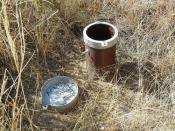interesting topic good work
Salt Pollution
As awareness for pollution increases, other forms of pollution are defined. Almost everyone knows about toxic waste and carbon dioxide pollution, but not many people have heard of salt pollution. Salt pollution has been on the increase since the evolution of the automobile. With more pressure on government agencies to keep the highway clear and safe, an increase in the use of salt has developed. It is important to understand why salt is used and how it work as well as the environmental effects to understand the salt pollution problem.
Salt is a necessary and accepted part of the winter environment. It provides safety and mobility for motorists, commercial vehicles and emergency vehicles.
Salt is used as the principal deicer because it is the most available and cost-effective deicer. Rock salt is preferred because it is cheap and effective. It costs 20 dollars a ton where as an alternative like calcium magnesium cost around 700 dollars a ton.
Some 10 million tons of deicing salt is used each year in the U.S. and about 3 million in Canada.
Salt is used to keep snow and ice from bonding to the pavement and to allow snowplows to remove. When salt is applied to ice and snow it creates a brine that has a lower freezing temperature than the surrounding ice or snow. Salt is the ideal deicing material because it is:
*the least expensive deicer
*easy to spread
*easy to store and handle
*readily available
*non-toxic
*harmless to skin and clothing
Salt pollution is broken into two main groups. Water, which includes the effects on ground water, surface water and aquatic life and land.
Most of the salt applied to the roadways eventually ends up in the ground water. It is estimated that 30%...



Works Cited
It would be helpful to include a works cited page. Here are some applicable sources in MLA format:
Works Cited
Bottle Biology. University of Wisconsin-Madison 10 October 2004. 17 September 2004 <Tab/><http://www.bottlebiolo gy.org/investigations/terraqua_explore.html> ;
Fence, Franky. "Road safe of environment safe?" CNN 10 October 2004. 25 June 2004 <Tab/><www.cnn.com>
G allagher, Daniel. "Effects of Road De-icing Salts on Groundwater Systems." Virginia <Tab/>Polytechnic Institute and State University 10 October 2004. November 2003 <Tab/><http://www.ce.vt.edu/p rogram_areas/environmental/teach/gwprimer/roadsalt /roa<Tab/>dsalt.html>
Keller , Janet. Salt Institute 10 October 2004. 3 March 2002 <Tab/><http://www.saltinstitu te.org/30.html>
Roberson, Todd. "Pollution." 10 October 2004. 15 August 2003 <Tab/><http://www.protectingw ater.com/>
0 out of 0 people found this comment useful.